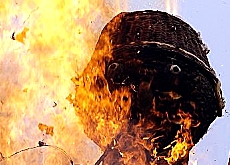
Zurich’s winter spirits take their time

Thousands of people dressed in historic costumes have taken part in Zurich’s traditional spring festival, the "Sechseläuten".
The cotton ball snowman, the “Böögg”, exploded after almost 18 minutes, an apparent sign of rather mixed summer weather ahead.
It took 17 minutes and 51 seconds for the explosive-laden head of the three-metre high effigy of a snowman atop a pyre to blow off on Monday.
Last year the Böögg exploded in just 11 minutes.
Local legend has it that the quicker the head bursts apart, the better the weather will be in summer.
The fire marks the climax of the four-day festival, which is usually held over the third weekend in April.
Some 3,500 members of Zurich’s once powerful guilds dressed in historic costumes and representing the various trades, took part in Monday’s pageant in Switzerland’s main city.
About 1,000 children along with horses and marching bands also paraded to a public park near the lakeside where the snowman was waiting on a bonfire.
They were accompanied by 1,300 musicians and more than one hundred guests of honour, including Justice Minister Christoph Blocher, members of cantonal governments, parliamentarians and prominent scientists, with thousands of onlookers lining the streets.
Einstein’s wife
To coincide with the festivities the city’s only women’s guild and the Federal Institute of Technology in Zurich honoured Mileva Einstein-Maric, the first wife of Nobel Prize winner Albert Einstein.
Maric, a mathematician, and her husband met in Zurich in 1896. She played an important part in Einstein’s discovery of the theory of relativity.
A special ceremony was held at the Federal Institute and the women’s guild revealed a metal plaque at a house in Zurich where the couple used to live.
The Sechseläuten festival in its current form dates back to 1867.
It derives its name from the fact that at the spring equinox the bells of Zurich’s main cathedral would toll vespers again at six o’clock to announce the end of the working day.
In winter time the working day lasted only until five o’clock due to early dusk.
swissinfo with agencies
The traditional Sechseläuten (“Six o’clock bells”) festival marks the arrival of spring.
It is a procession of Zurich’s guilds and culminates with the burning of an effigy of a giant cotton ball snowman (“Böögg”) on Monday at 6pm.
Legend has it that the quicker its head bursts apart, the better the summer will be.

In compliance with the JTI standards
More: SWI swissinfo.ch certified by the Journalism Trust Initiative




























You can find an overview of ongoing debates with our journalists here . Please join us!
If you want to start a conversation about a topic raised in this article or want to report factual errors, email us at english@swissinfo.ch.